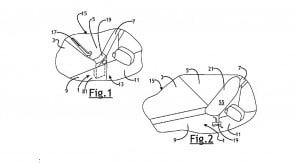Automakers have spent the last 30 years perfecting the airbags that protect the passengers inside the vehicle, but now General Motors and others are turning their attention to pedestrians.
General Motors recently filed a patent for an exterior airbag that would protect pedestrians in the event of a collision. The company was granted a patent last week for its “Fender Located Pedestrian Airbag,” according to TheTruthAboutCars.com.
The patent is for an airbag developed by the automaker that pops out of the a-pillar and covers the windshield to being released from a fender flap in order to inflate and cover the windshield wiper arms and other sharp pieces on the front end of the vehicle.
GM is just the latest automaker to gain a patent for exterior airbags. In August, Mercedes-Benz also received a patent for an A-pillar based airbag that also incorporates a design where the hood pops up allowing for another airbag to provide additional protection.
(Key Safety Systems agrees to $1.6B purchase of Takata assets. Click Here for the story.)
In Mercedes iteration, the bags remain hidden from the outside, in a “fabric tube.” The filing states would “slightly” impede the driver’s view in comparison to a conventional A pillar. The bags protect bodies that come up the hood from the parts of the vehicle that compose its shape, i.e. pillars.
Regardless of the basic design, there are still several engineering issues facing the exterior airbag, such as how would they adapt to weather conditions, such as snow and extreme cold to rain to extreme heat.
(Click Here for more about GM’s plans for the future according to CEO Mary Barra.)
Volvo’s airbag, which never got past the “maybe” stage on the V40, was a passive airbag designed to deploy at speeds of less than 31 miles per hour to help limit head injuries to pedestrians. After early suggestions in 2013 it may show up on the XC90, Volvo shelved in favor of active technologies designed to prevent collisions
The technology is difficult to perfect because it requires several components such as airbag module, hood lift limiter and sensors, and others to work in perfect harmony, often in imperfect conditions. They are contained in an exterior part of the vehicle that include inside the front panel of the vehicle and inside the tires, among others.
(To see more about GM’s Marketplace technology, Click Here.)
The sensors, which are integrated with airbags, detect a collision with a pedestrian at speeds 20 to 50 Km/h and trigger the deployment of the airbags. The reaction time of the automotive external airbag is approximately 20 to 30 milliseconds.

